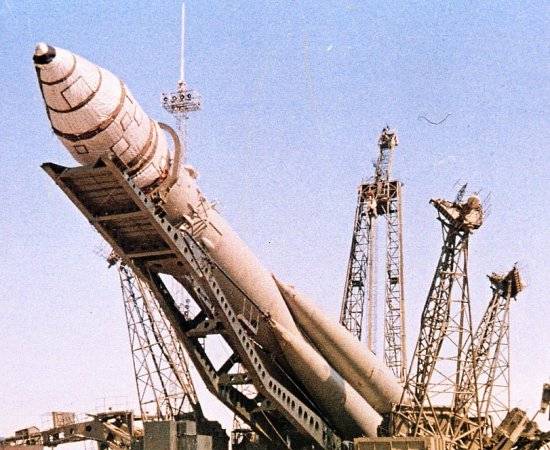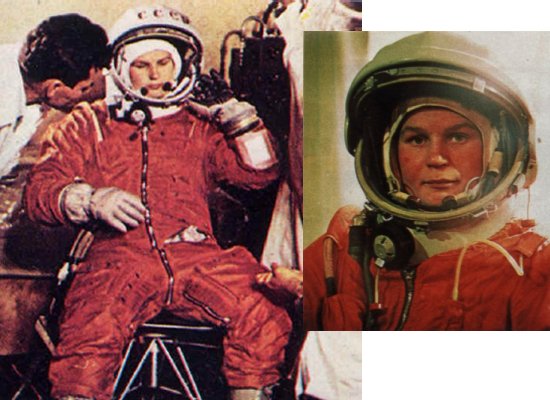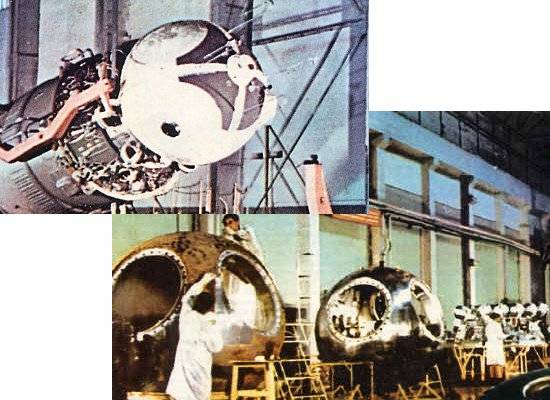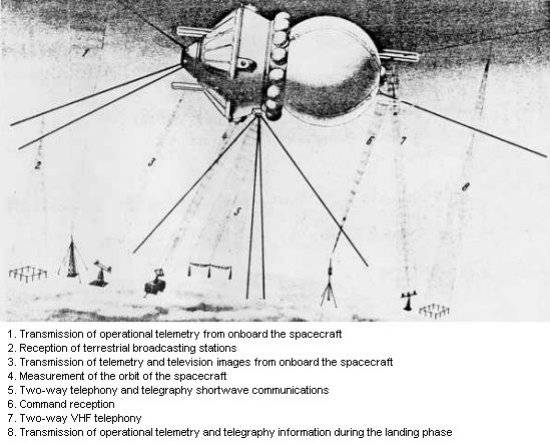|
||||||||||
|
|
||||||||||
|
||||||||||
|
|
||||||||||

A site supporting many of the sensational claims of the Judica-Cordiglia brothers has been established at The Lost Cosmonauts while another site documenting various critiques of the brother's claims is Encyclopedia Astronautica. A particularly qualified space flight expert who has investigated the Torre Bert stories is former NASA engineer, historian, and author James Oberg. Additional experts who have been critical of the Judica-Cordiglia brothers include Sven Grahn of the Swedish space program and an amateur spacecraft tracker as well as amateur astronomer Thierry Lombry. The bulk of this article is based on information from these sources.
Before addressing the Torre Bert stories in detail, we first need to establish some background to better understand events going on during that time period. The space race had begun in October 1957 when the Soviet Union successfully launched the first artificial satellite named Sputnik. The United States was not able to duplicate the feat until the launching of Explorer I in February 1958. By April 1961, the Soviets had successfully launched Yuri Gagarin into orbit and America answered with Alan Shepherd's suborbital flight the following May. The US did not complete its first manned orbital mission until John Glenn flew in February 1962. The Soviets continued to lead the way in space flight when the first woman in space, Valentina Tereshkova, flew during June of 1963 and accumulated more time in space than all of America's astronauts combined.

It was during this exciting time that the Judica-Cordiglia brothers in Italy became fascinated with space travel. The two became involved in ham radio in 1949 when Achille was 16 and Gian was just 10. By 1959, the family had moved to Turin where the brothers decided to dedicate their hobby to listening in on satellites being launched by the Soviet Union and the US. The two devoted most of their attention to the Soviet program given their closer proximity to the USSR. Furthermore, the Soviet space program was far more mysterious than that of America since the Russians were typically very secretive and often did not announce anything about a mission until it had concluded. NASA, on the other hand, usually conducted its missions in full view of the press. The brothers claim that it was the spirit of secrecy that inspired them concentrate on learning more about what the Soviets were really doing.
During late 1960 and early 1961, the equipment at the Torre Bert listening post was operational and the brothers began monitoring spacecraft flying overhead. However, they had difficulty tracking these objects at their high rate of speed, so the two reportedly built a handmade movable tracking dish to follow craft across the sky. They went even further by building their own tracking displays like those used by NASA to pinpoint the location of a spacecraft moving in its orbit around the Earth. Without any technical knowledge, they also claim to have devised methods of filtering noise from their recordings of spacecraft signals, determining whether a transmission came from the craft or ground control, calculating the craft's orbital path, and locating the radio frequencies used by Soviet tracking stations.

The operation became even more elaborate when the brothers sought out partners around the world to build their own amateur space-tracking network, dubbed the Zeus network. When the brothers detected signs that a new launch was pending, they'd use shortwave radio to notify sixteen other stations across Europe, the Americas, Africa, and the Pacific to be prepared. Gian Battista's fiancée was enlisted to coordinate these amateur stations while the brother's sister Theresa was given the job of learning Russian to translate any signals they received.
Experts generally agree that the Judica-Cordiglia brothers did build a legitimate tracking station and were able to record signals from some actual missions. However, the pair also claimed a number of remarkable recordings of events that have never been acknowledged by the Soviet Union or by advanced tracking stations in the United States and the United Kingdom that also monitored Soviet flights. One of the most amazing of these alleged recordings was a supposedly troubled manned mission in November 1960, before Gagarin's flight, that transmitted a message in Morse code saying, "SOS TO THE WHOLE WORLD." Another recording collected in February 1961 is supposed to contain heavy breathing and the rapid heartbeat of a dying cosmonaut.

The particular legend that sounds most like the story you describe involved a female cosmonaut who was somehow attributed with the name Ludmila. The date of her supposed flight has changed over the years, but the Italian newspaper Corriere della Sera first reported the sensational story in March 1965. The article described a radio intercept collected by the Judica-Cordiglia brothers describing the orbital flight of a woman launched in November 1963 who died during re-entry. The story went on to describe how the female passenger reported increasing temperatures as her capsule burned up in the atmosphere while making "heart-rending" pleas asking what was wrong. A sample of the recording is available at Lost Cosmonauts and includes a transcript of the alleged transmission.
Later on, the date of this flight was revised to a much earlier date of 16-19 May or 19-23 May 1961, which is even earlier than Valentina Tereshkova flew. Some sources also indicate that this flight might have included both the female passenger and two male cosmonauts engaged in a tense conversation. Among the quotes attributed to them is the statement, "Conditions growing worse why don't you answer? ... we are going slower... the world will never know about us..." Such a mission would have been impossible unless the Soviets had developed a larger space capsule since the Vostok capsules being flown at the time had room for only one passenger.

Despite these salacious stories, however, most experts have discounted the Torre Bert claims due to the limitations of its tracking equipment and details that are inconsistent with known facts about the Soviet space program. In particular, Sven Grahn and Thierry Lombry have criticized the antennas and radio gear used at Torre Bert as being insufficient to record the kinds of signals the Judica-Cordiglia brothers claim to have obtained. Their main tracking antenna, for example, required manual turning to track a moving target across the sky, a difficult feat considering that spacecraft travel from horizon to horizon in just a few minutes.
The two experts also question some of the radio frequencies the Judica-Cordiglia brothers say were used for Soviet space transmissions. Not only were some of these frequencies reserved for other purposes, but the brothers also claim they received facsimiles of pictures transmitted from spacecraft that simply would not be detectable using the amateur antennas mounted at Torre Bert. The story about hearing heartbeats is also disputed since this kind of information was not transmitted over a voice channel on any manned Soviet missions. Biomedical information like heart and breathing rates were converted into electrical signals, combined together, and transmitted as numerical telemetry data. Telemetry signals sound like nothing but static over an audio channel.

Although the Judica-Cordiglia claims face intense skepticism today, it is remarkable how widely accepted they were during the 1960s. Respected publications like the Washington Post and Reader's Digest wrote several stories of Torre Bert throughout the mid-1960s. Yet in spite of this press attention, the Zeus network lasted only a year and Torre Bert was closed down in 1966. Following its demise, Achille and Gian Battista Judica-Cordiglia went on to become highly respected in the fields of cardiology and forensics. Gian Battista also made a name for himself as a scientific investigator of the shroud of Turin.
The popularity of Torre Bert in its heyday can probably be attributed to the secrecy surrounding the Soviet space program as well as a certain fear and jealousy in the West over the Soviet's many accomplishments. While any failures of the American space program were front-page news, the lack of an open press in the USSR allowed the Soviet program to hide most of its flaws. Since rocketry and space flight were state-of-the-art technologies, there was a feeling in the West that Soviets must have suffered similar setbacks to NASA's, but these were simply not reported. Indeed, we know today that early Soviet rockets failed even more often than did America's. It was because of this fear and secrecy that stories about lost cosmonauts found such fertile ground in the minds of Western audiences.

Now that the Cold War has ended, the records of the Soviet space program have been opened and its failings have been exposed. Stories that had been successfully hidden for so long are now well known, such as the death of cosmonaut trainee Valentin Bondarenko, the massive casualties of the Nedelin Disaster, and the utter failure of the N1 lunar rocket. All of these events had existed as rumors in the USSR long before the fall of the Iron Curtain and were spread to the West by defectors, but most were not truly understood until the Soviet Union collapsed. By then, eye witnesses and family members were free to speak, personal diaries from those involved could be read, and official government records were obtained to confirm these rumors.
The tales that the Judica-Cordiglia brothers tell, on the other hand, never appeared in any form in the Soviet Union. There are no engineers from the Soviet space program who've said they worked on one of these failed missions, no family members who've spoken up for their martyred relatives, and no official or unofficial records of any kind to corroborate these rumors. The only proof we have that these events ever occurred come not from Russia, but from two brothers in Italy who have nothing to offer but a few garbled tapes that most observers cannot even decipher. While there is no absolute evidence to completely discount the Torre Bert claims, there is no proof to confirm them either. Until new evidence emerges to the contrary, we are forced to conclude that these missing cosmonauts never actually existed and the tales of their untimely deaths are nothing more than legend.
To learn more about this subject, see the works of James Oberg who has been researching the Soviet space program
for over 30 years. Samples of Oberg's writings can be found in his 1975 article
Phantoms of Space that explores the veracity of
several lost cosmonaut tales and a chapter from the book Uncovering Soviet Disasters that discusses
Dead Cosmonauts.
- answer by Jeff Scott, 3 July 2005
Read More Articles:


|
Aircraft | Design | Ask Us | Shop | Search |

|
|
| About Us | Contact Us | Copyright © 1997-2023 | |||
|
|
|||